When it comes to birds of prey, then Kestrels in Ireland are probably the birds most frequently seen.
Find out more about these fascinating birds and how you can help them in this article.
This post may contain affiliate links. If you click on one of them, we might receive a small commission (at no extra cost to you). Thanks for your support!
Table of Contents
- 1 What is a Kestrel bird?
- 2 Kestrels in Ireland
- 3 How big is a Kestrel?
- 4 What do Kestrels look like?
- 5 What is the Kestrel call?
- 6 What do Kestrels eat?
- 7 How does a Kestrel hunt?
- 8 Where are Kestrels often seen?
- 9 Where do Kestrels nest?
- 10 Kestrel Birds of Prey Reproduction
- 11 Do Kestrels mate for life?
- 12 Kestrel Bird Ireland FAQ
What is a Kestrel bird?

The Kestrel is also known as the European Kestrel, Eurasien Kestrel and by the name of Windhover, due to its skill as a hovering bird of prey.
There are several types of Kestrel, but only the Common Kestrel is present in Ireland and Britain, which is why the species is usually referred to as simply “Kestrel”.
The Common Kestrel (Latin Name: Falco tinnunculus) is a small bird of prey that has a widespread distribution across Asia, Africa as well as Europe.
Kestrels in Ireland
Kestrels are one of the best known falcons in Ireland. They play an important role in the biodiversity and health of ecosystems as they provide essential ecosystem services by contributing to pest control.
In the past, Kestrels were widespread throughout Ireland, but their numbers are declining and the species is on the red list of species of concern. They are still one of the most common birds of prey seen in Ireland.
Ireland is just one of the areas in their relative wide geographic range that spans across Asia and as far south as South Africa. There is much still to learn about the population of Kestrels in Ireland, particularly the feeding habits and overwintering areas.
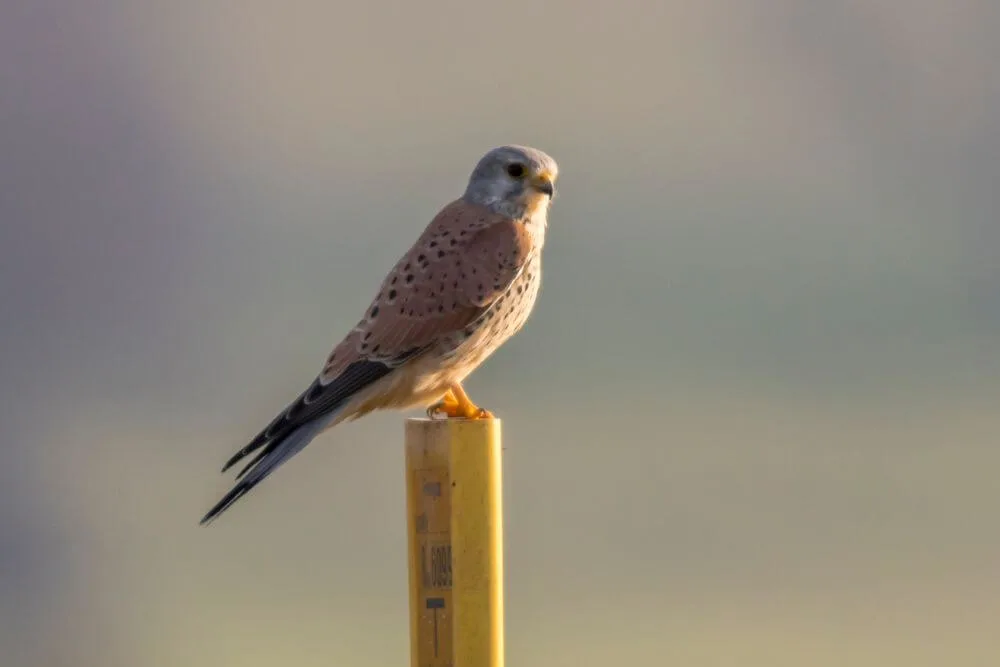
Kestrel Ireland – Name in Irish Language
In Irish, the name for Kestrel is also reflected in its agility in the air. The name Pocaire Gaoithe means “Wind Frolicker”. It is also called the Púicín gaoithe or “Little Wind Pooka”.
How big is a Kestrel?
Male and female Kestrels differ in size and their plumage. Female Kestrels are slightly bigger than males, but the difference in Kestrel size is not hugely noticeable, especially at a distance. The Kestrel wingspan is between 60-80 cm (24-32”) and their length is usually between 32-50cm (12-20”).
What do Kestrels look like?
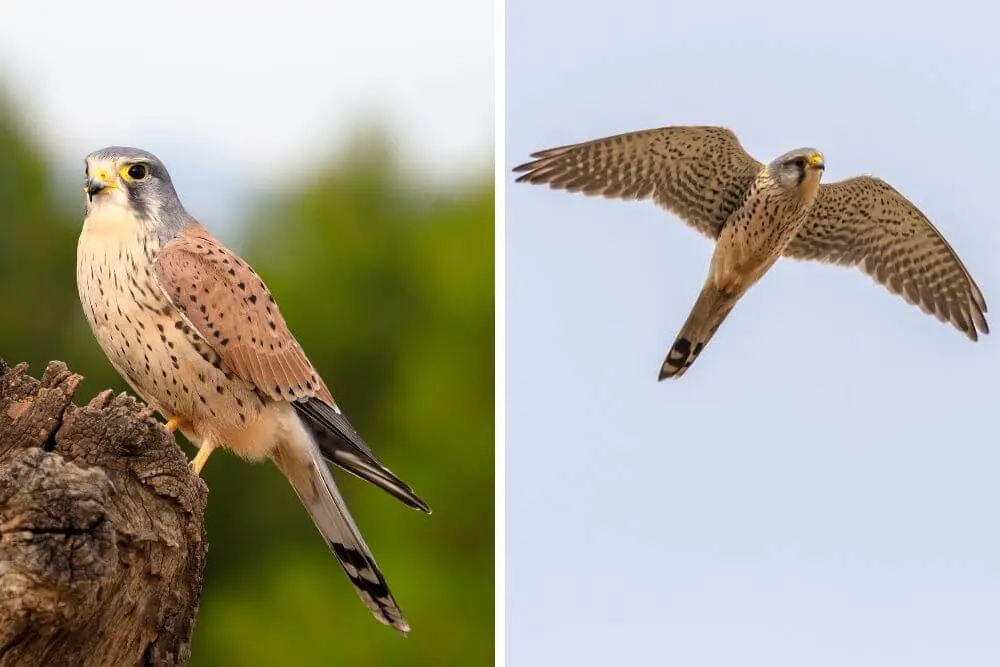
Male Kestrel birds have a gray colored head, with a mustache at the side of the bill. Their chest area is best described as creamy colored with dark brown dots. Its wings are typically a rich chestnut color with black spotted areas and black times. The tail of the males is long and gray with a black tip.
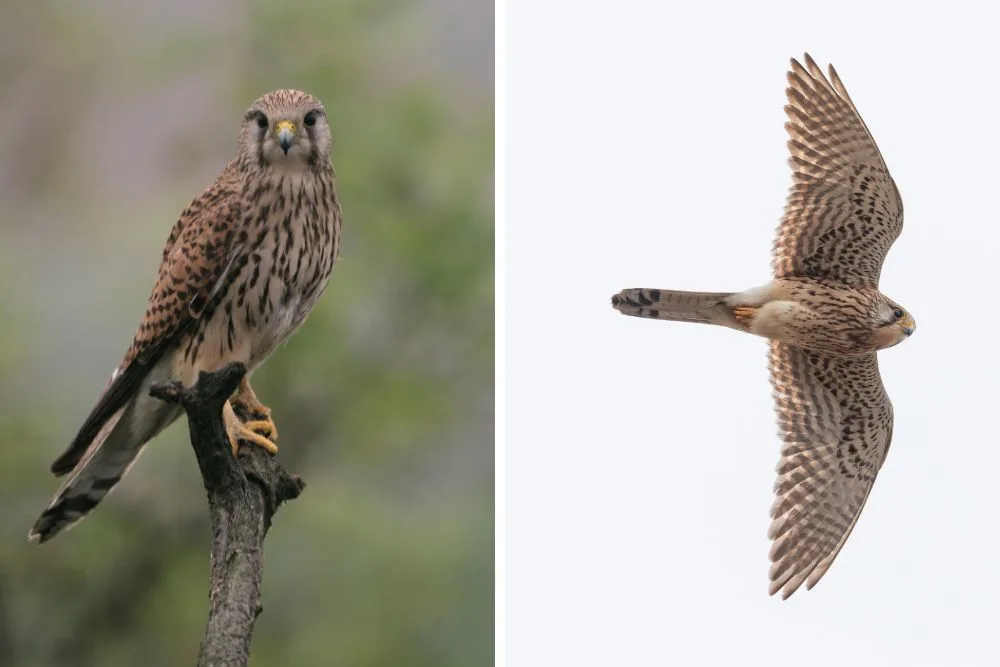
Females are not quite as colorful, but also have impressive plumage. Their heads are brown and the chest has streaked coloring (rather than the dots seen on the males). The wings of the Common Kestrel female are barred in brown and the tips are darker. On the females the tails also have brown barred markings and the tip of the tail is black.
The eyes and feet are yellow, as is the soft fleshy park above the bill (known as the cere).
It can be difficult to tell the adult females and the juvenile Kestrel birds apart as their plumage colorings are similar.
You are most likely to catch a glimpse of a Kestrel hovering over the ground in surveying its prey.
Kestrel Feathers
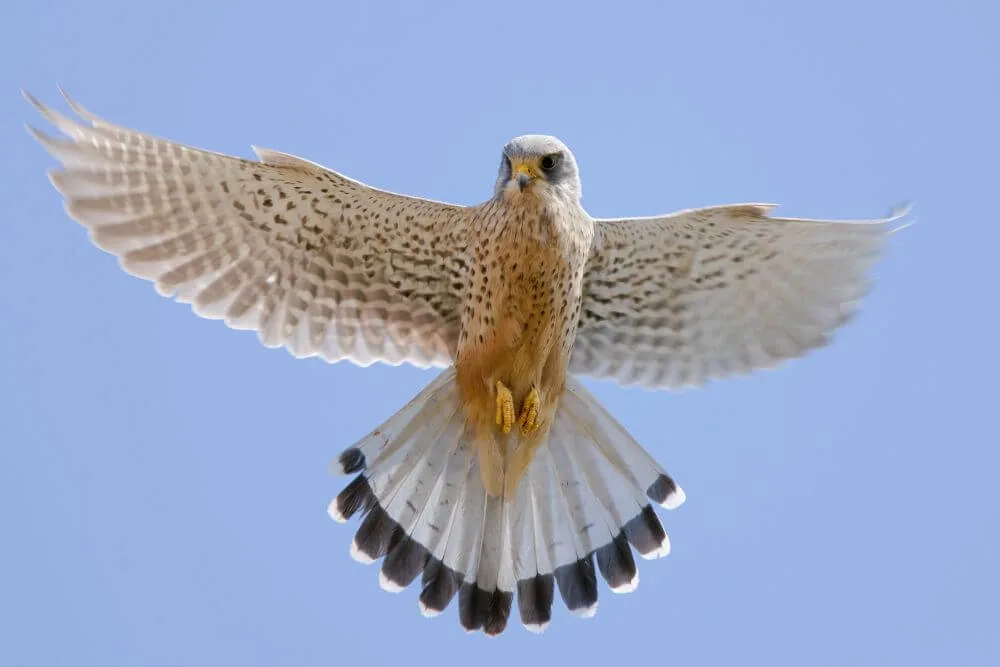
The Kestrel wing feathers are specially adapted to enable air to flow through them while they are hovering. This enables Kestrels hovering over the ground to reduce the turbulence and prevent them from stalling and simplifying tumbling to the ground while they hover.
What is the Kestrel call?
The Kestrel produces a series of sharp, shrill shrieks. Here is a video of the Kestrel call.
What do Kestrels eat?
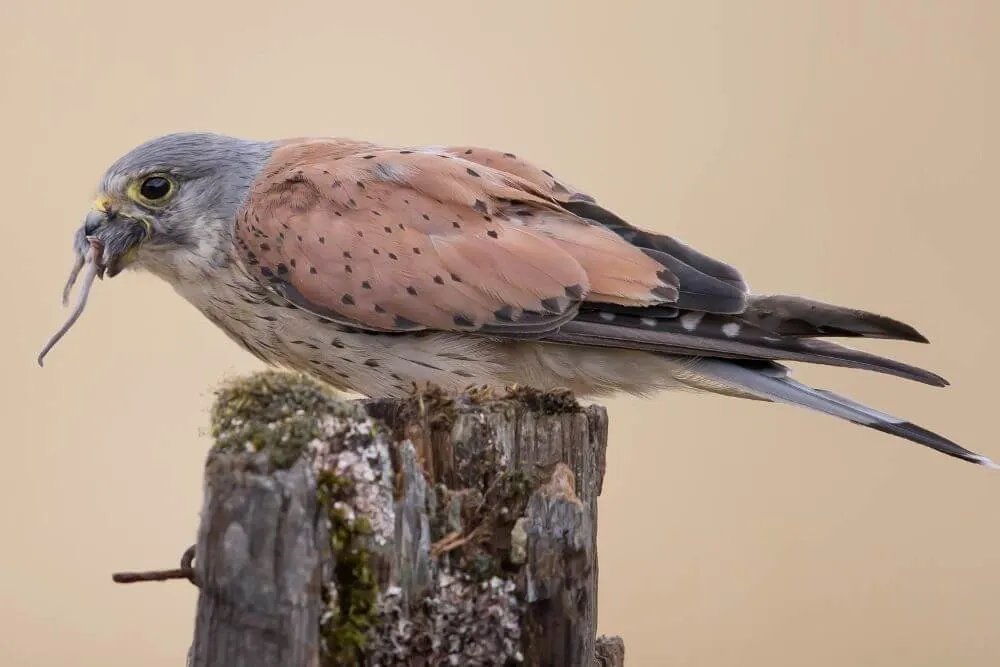
Kestrels are keen hunters that eat a wide range of small prey. The diet of a Kestrel is typically made up of small mammals, birds and insects. They are adaptable feeders whose diet can vary considerably depending on the availability of prey in the habitats where the bird lives and hunts.
While voles seem to be a particular favorite type of Kestrel prey (voles are an energy packed snack with high fat content in comparison to bird prey), studies that have analyzed the contents of food pellets of undigested food have found that Krestels also prey a lot on birds and insects depending on availability.
Kestrels need to make between 4-8 kills a day in order to sufficiently feed themselves and their young.
If there are good hunting opportunities, Kestrels will continue to hunt and store their food to be eaten later, often on a high up perch.
Kestrel Diet
Do Kestrels eat small mammals?
Ireland does not have many small mammal species, so it is believed that birds make up a significant amount of the diet of Kestrels on the island.
The Kestrel is found to feed on all four small native mammal species found in Ireland:
- field mouse (Apodemus sylvaticus)
- house mouse (Mus domesticus)
- brown rat (Rattus norvegicus)
- tiny pygmy shrew (Sorex minutus)
In addition, two other relatively recently introduced species of small mammal, the bank vole (Myodes glareolus) and the greater white-toothed shrew (Crocidura russula) also supplement the diet of the Kestrel and other birds of prey in Ireland.
Not only do Kestrels have excellent eyesight, they can also see in the ultraviolet spectrum, which is a great advantage for them. The ultraviolet urine trails that these small mammals leave behind make it easier for the Kestrel to spot and hunt their prey.
Do Kestrels eat birds?
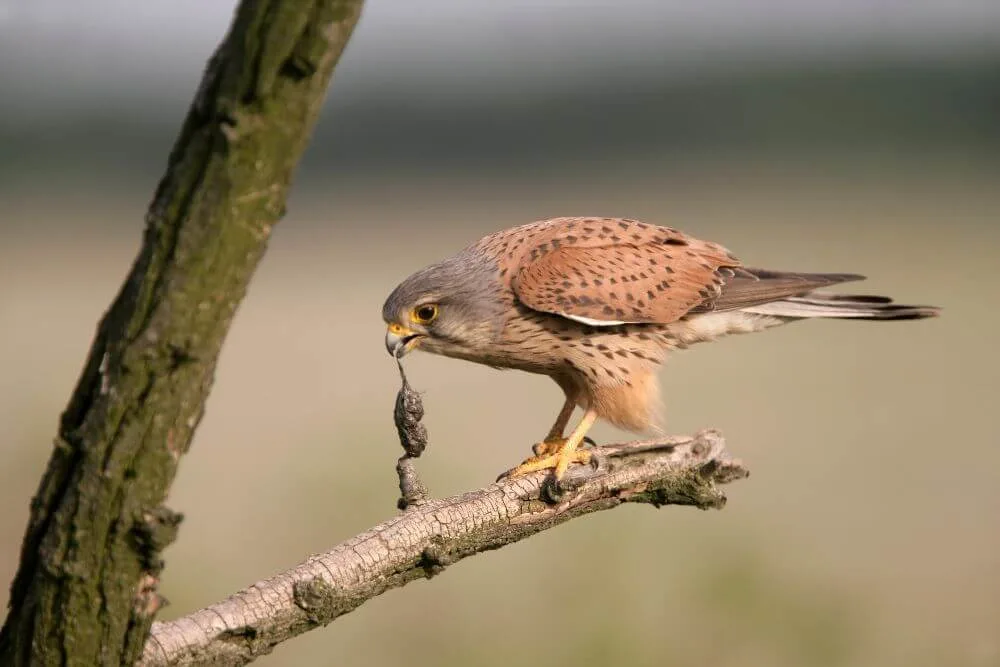
Yes. Due to the widespread availability, avian prey is believed to play a particularly important role in the diet of Irish Kestrel birds (this is also due to the limited number of small mammals in Ireland).
Kestrels are opportunistic feeders by their nature and often focus on small passerine birds. These birds are those with three toes facing forwards and one pointing backwards, which allows them to perch easily. This makes them easier targets for birds of prey, such as Kestrels. Common passerines that feature in the diet of Kestrels include common garden birds such as Starlings, Blackbirds, Robins, Tits, Finches and many others.
Do Kestrels eat Pigeons?
While typically Kestrels will opt to hunt small birds, if the opportunity arises, larger birds such as pigeons are on the menu for Kestrels.
Insects and and Other Food Sources
Kestrels will also eat small insects, mainly beetles, and also other invertebrates such as worms, spiders.
Frogs and lizards also sometimes make up small parts of the diet of Kestrels.
How does a Kestrel hunt?
Usually the Kestrel hunts its prey in open habitats including agricultural areas, grassland, or coastal areas, where it has a good view of the ground below. It employs a technique called “wind-hovering”.
Once the Kestrel has spotted its prey, it hovers in the air, with its tail fanned and keeping its head completely still, waiting for the optimum moment to start a short dive and capture its meal.
In order to stay in one place, the Kestrel must face the wind to have enough updraft and adjust their wings and tail feathers to maintain their position relative to the ground. This technique allows them to survey their prey until the time is right to launch their attack, thus increasing the likelihood of having a successful hunting outcome.
In Ireland, there are some other birds of prey that hover (or at least have the ability to hang in the wind). You might even wonder if the hovering bird is a Buzzard or Kestrel, but if there is any doubt, the Kestrel is by far the master of this technique.
Kestrels will also occasionally hunt from a perch above the ground or fly close to the ground and launch a surprise attack on their prey. Rarely do they target prey that is flying in the air.
Where are Kestrels often seen?
Kestrels are sighted in a wide variety of different habitats, these include agricultural, coastal, forestry, grassland, freshwater areas and even occasionally urban environments.
In Ireland, agricultural areas are one of the main areas where they hunt and are likely to be seen. However, Kestrels are found close to the coast as they often tend to nest on cliffs. They can also be seen near areas of forestry, where they also establish their nesting sites.
Where do Kestrels nest?
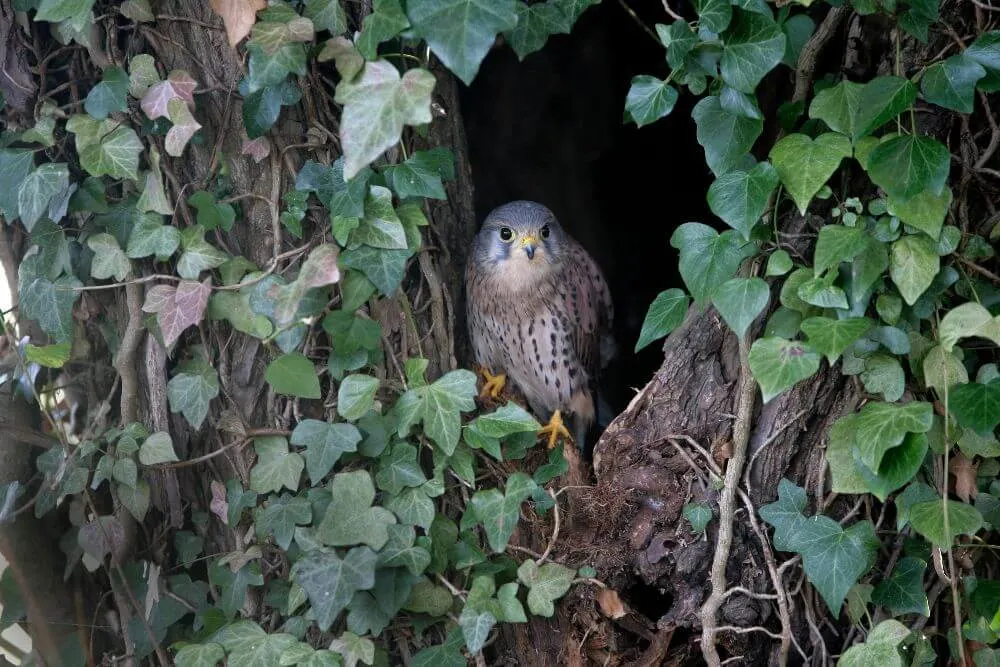
Kestrels don’t actually build their own nests, instead they use the nests of other corvid bird species such as jackdaw, rooks and crows for example.
Alternatively, cliff faces, holes in trees, cavities in the roof areas of buildings or even bridges (in some cases motorway bridges) are some of the other nesting locations of Kestrels.
In some areas, the nesting options for Kestrels are limited due to habitat destruction, changes in land use practices, climate change, as well as reliance on the nests of other birds. This hinders their breeding success and contributes to the decline of the species.
Kestrel Birds of Prey Reproduction
Kestrels typically lay between 4-6 eggs once a year during late April and May. It is usually the role of the female to incubate the eggs and the male will often be seen traveling back and forth to the nest delivering food to her or leaving it for her near the nest.
Once the chicks hatch then both the male and the female help to hunt and deliver food to the ever hungry brood of chicks.
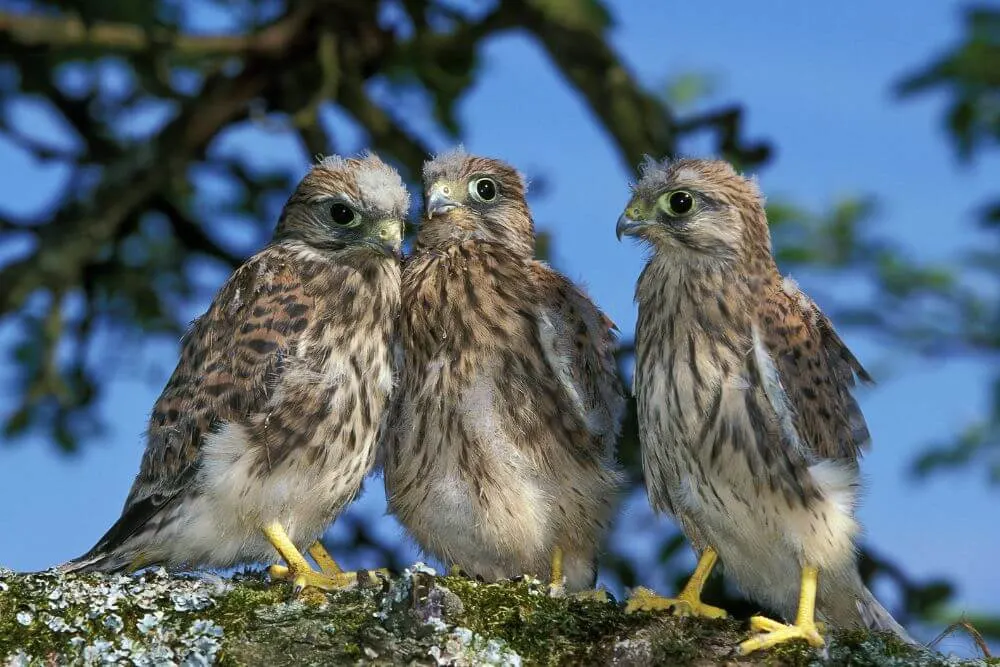
After about 4-5 weeks the chicks fledge (generally about 3-4 chicks in total) and leave the nest for the first time, but the parents and fledglings remain together for several weeks (typically 4-5) in order for the younger birds to learn and master the essential skills that they will need to survive as independent adult birds.
The birds that survive their first winter are sexual mature to raise their first bood the following year.
Do Kestrels mate for life?
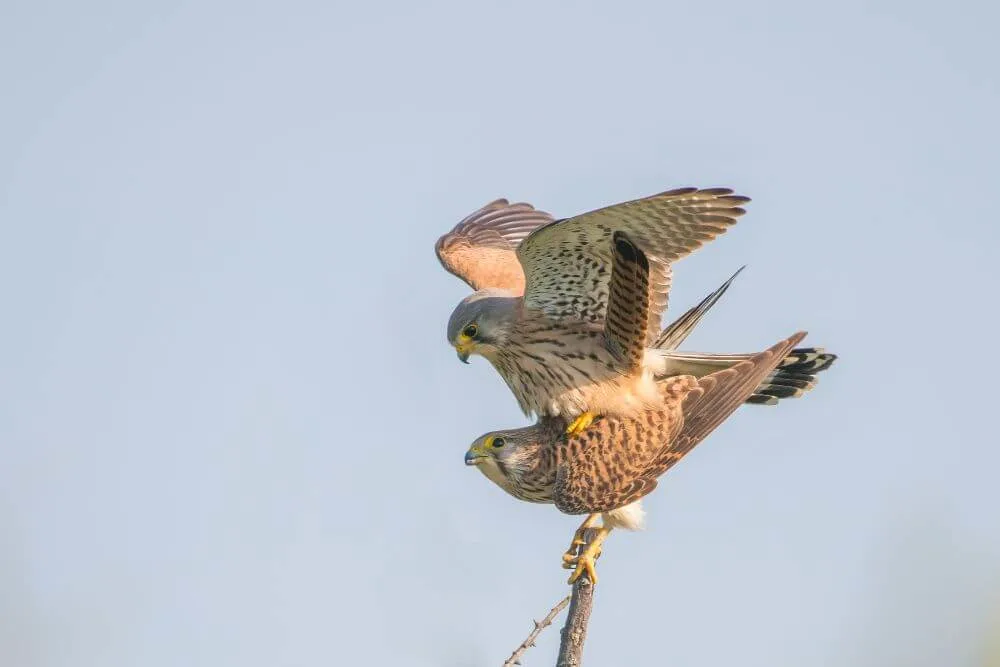
Kestrels tend to mate with the same partner for a long period of time, quite often probably for their entire life.
Kestrel Bird Ireland FAQ
What is the lifespan of a Kestrel?
Most Kestrels only live to be about 2 years old in the wild and only breed once. Given the right conditions, they can live to be a lot older. The oldest tagged individual was a little more than 16 years old.
The population of Kestrels is declining in Ireland and Britain. In other areas within its range, the Kestrel is not considered to be endangered, but in Ireland the Kestrel is now red-listed and is a conservation concern. Agricultural intensification, habitat destruction, as well as the widespread use of rat poison, which results in the secondary poisoning of Kestrels and other wildlife including birds of prey are thought to be some of the main factors behind the population declines.
What is the difference between the American Kestrel and the European Kestrel?
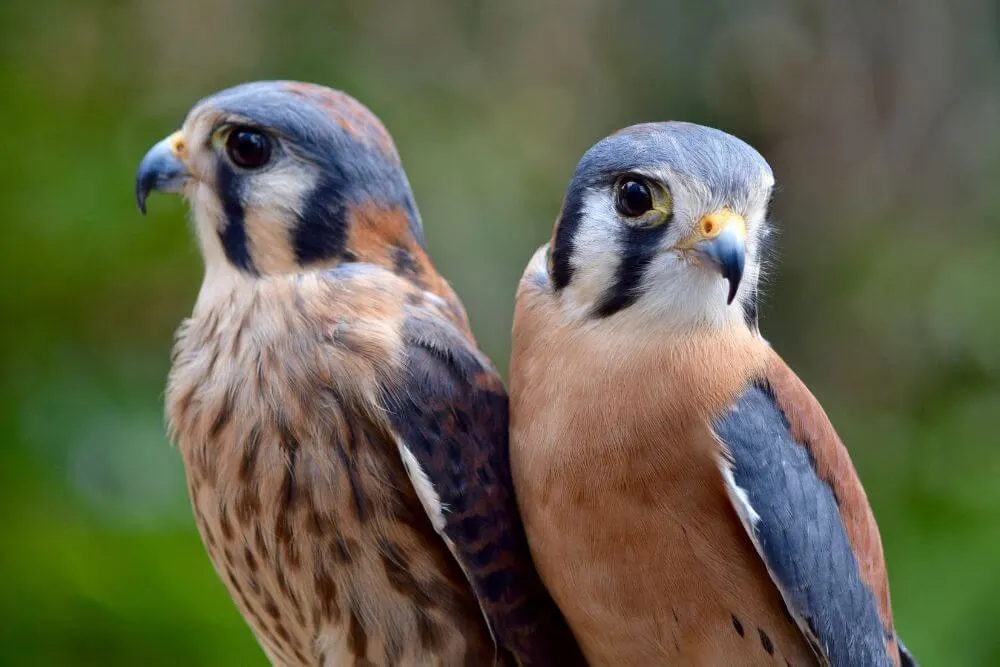
The Common Kestrel (Falco tinnunculus) is bigger and less colorful than the American Kestrel (Falco sparverius). The American Kestrel is also called a “Sparrowhawk”.
The American Kestrel is found in both North and South America and while it looks somewhat similar to the European Kestrel, recent genetic analysis has shown that it is genetically closer to other American falcons, such as the prairie falcons.
What can I do to help the Kestrel in Ireland and Northern Ireland?
There are lots of different opportunities for you to support and get involved in a bird survey or by monitoring of Kestrels and other raptors on a local or more national level.
One easy way to get involved is to track any sightings of Kestrels or other birds of prey via the Bird Track Phone App.
This citizen science effort helps to create useful data that scientists can use to gain greater knowledge and understanding about these birds. Kez Armstrong is just one scientist who has made use of such data in the last year or two as part of her work to gain invaluable insights into the behavior and ecology of Kestrels in Ireland.
Other resources for bird sighting include:
Every little contribution helps when trying to protect the natural heritage of Ireland and grow the knowledge base around these protected bird of prey species.
For more information about the birds of Ireland, such as Irish Birds of Prey including Sparrowhawks, Peregrine Falcons, Golden Eagles and White Tailed Eagles (as well as some information about the National Parks and Wildlife Service live webcam on a White Tailed Eagle nest on Garnish Island), read the Birds of Prey Ireland post.

(Irish Nature Expert and Celtic Enthusiast from Ireland)
Emer Walker, founder of LetsGoIreland.com, is a Cork native with profound expertise in Irish nature and ecology. Holding a PhD in Restoration Ecology and backed by extensive research in ecological sciences, she’s delved deep into Ireland’s natural wonders, from its rugged landscapes to its serene beaches. Emer’s passion also encompasses Celtic art and traditions. As a true authority on Ireland’s natural and cultural heritage, she invites readers through LetsGoIreland.com to immerse themselves in the authentic Irish experience.
